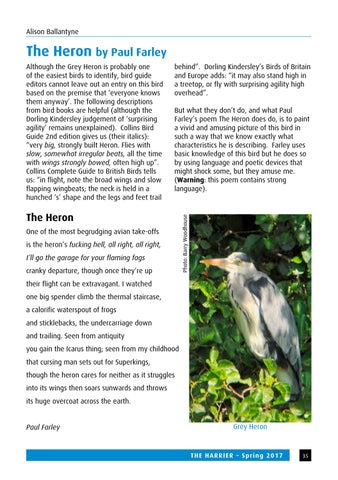Alison Ballantyne
The Heron by Paul Farley behind”. Dorling Kindersley’s Birds of Britain and Europe adds: “it may also stand high in a treetop, or fly with surprising agility high overhead”. But what they don’t do, and what Paul Farley’s poem The Heron does do, is to paint a vivid and amusing picture of this bird in such a way that we know exactly what characteristics he is describing. Farley uses basic knowledge of this bird but he does so by using language and poetic devices that might shock some, but they amuse me. (Warning: this poem contains strong language).
The Heron One of the most begrudging avian take-offs is the heron’s fucking hell, all right, all right, I’ll go the garage for your flaming fags cranky departure, though once they’re up
Photo: Barry Woodhouse
Although the Grey Heron is probably one of the easiest birds to identify, bird guide editors cannot leave out an entry on this bird based on the premise that ‘everyone knows them anyway’. The following descriptions from bird books are helpful (although the Dorling Kindersley judgement of ‘surprising agility’ remains unexplained). Collins Bird Guide 2nd edition gives us (their italics): “very big, strongly built Heron. Flies with slow, somewhat irregular beats, all the time with wings strongly bowed, often high up”. Collins Complete Guide to British Birds tells us: “in flight, note the broad wings and slow flapping wingbeats; the neck is held in a hunched ‘s’ shape and the legs and feet trail
their flight can be extravagant. I watched one big spender climb the thermal staircase, a calorific waterspout of frogs and sticklebacks, the undercarriage down and trailing. Seen from antiquity you gain the Icarus thing; seen from my childhood that cursing man sets out for Superkings, though the heron cares for neither as it struggles into its wings then soars sunwards and throws its huge overcoat across the earth. Paul Farley
Grey Heron
T H E H A R R I ER – S p r i n g 2 0 1 7
35
